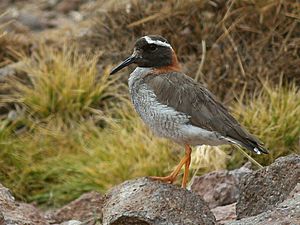Diademed sandpiper-plover facts for kids
Quick facts for kids Diademed sandpiper-plover |
|
|---|---|
 |
|
| Conservation status | |
| Scientific classification | |
| Genus: |
Phegornis
|
| Species: |
mitchellii
|
 |
|
The diademed sandpiper-plover (Phegornis mitchellii) is a special type of bird. It's called a Near Threatened species, which means it could become endangered if we don't protect it. This unique bird lives high up in the Andes mountains in South America. You can find it in countries like Argentina, Bolivia, Chile, and Peru.
Contents
About the Diademed Sandpiper-Plover
What Kind of Bird Is It?
The diademed sandpiper-plover is the only bird in its group, called Phegornis. For a while, scientists thought it was a type of sandpiper. But now, we know it's a true plover. It belongs to the plover family, Charadriidae. It seems to be related to some plovers found in Australia and New Zealand.
How to Spot a Diademed Sandpiper-Plover
This bird is about 16.5 to 19 centimeters (6.5 to 7.5 inches) long. It weighs between 28 and 46 grams (about 1 to 1.6 ounces). Both male and female birds look alike.
Their bill is black and curves slightly downwards. Their legs and feet are bright orange. The adult bird has a black face with a wide white stripe above its eye. This stripe goes all the way around the back of its head.
The top of its head is black, and the back of its neck is a bright reddish-brown. Most of its upper body is dark brownish-gray. Its lower back and upper tail feathers are black. The tail is black with white tips on the feathers.
Its throat is white. Its chest, belly, and sides have black and white stripes. The area under its tail is plain white. Young birds look a bit duller than adults. Their upper parts are brownish-gray with cinnamon spots and stripes. Their eye stripe is grayish, and their neck has a hint of cinnamon or reddish-brown.
Where Do Diademed Sandpiper-Plovers Live?
You can find the diademed sandpiper-plover in the Andes mountains. This range stretches from central Peru, south through western Bolivia, and into central Chile and south-central Argentina.
These birds are very picky about where they live. They almost always live in special wet areas called peatlands and bogs. These places are found high up in the mountains, between where the frost starts and where the snow stays all year. Their home is usually a mix of grassy banks, long streams, and temporary pools of water.
In Peru, they live at very high elevations, from about 4,100 to 5,000 meters (13,500 to 16,400 feet). Further south, you might find them a bit lower, around 2,000 meters (6,500 feet).
Life and Habits of the Plover
How They Behave
Diademed sandpiper-plovers are almost always seen alone or in pairs. We don't know for sure if they always stay with one partner. It might be because there aren't many of them, or because they like to have their own space.
Seasonal Journeys
In the southern parts of their home range, these birds move to different elevations depending on the season. Birds that nest in the highest areas move to lower places in March. They return to the higher spots in October. Some birds from the very south might even fly north and south for the winter.
What They Eat
These plovers usually look for food alone or in pairs. They probe in wet ground or shallow water. They also pick up food from the water's surface and from water plants. We don't know all the details of their diet. But we do know they mostly eat small water creatures without backbones, like insects.
Nesting and Young Birds
Diademed sandpiper-plovers lay their eggs from October to December in Chile. In Bolivia, this period can last into January. Their nest is a simple hollow in the ground. Sometimes, they make a platform of dried grass. All the nests found so far had two eggs. We don't know how long it takes for the eggs to hatch or for the young birds to be ready to fly.
Their Calls
When a diademed sandpiper-plover is looking for food or flying, it makes a short, sharp call like "pic" or "pic-pic". When they are alarmed, they make different sounds. These can be a sad, drawn-out "wheehu", a sharper "whee-u!", or even a surprisingly loud, screamed whistle, "whEEHU!".
Protecting the Diademed Sandpiper-Plover
The IUCN (International Union for Conservation of Nature) says the diademed sandpiper-plover is a Near Threatened species. This means it's close to being endangered. It lives across a fairly large area. However, there are only an estimated 1,500 to 7,000 adult birds left. This number is believed to be going down.
Even though their habitat seems somewhat safe, there are threats. People need water resources, which can affect the bogs. Too much grazing by animals, new roads, and human activity also cause problems. On top of that, the special peatland ecosystems in the high Andes are expected to shrink a lot because of climate change. Scientists think up to 75% of these areas could be lost by around the year 2100. This makes protecting these unique birds and their homes very important.
See also
 In Spanish: Chorlitejo cordillerano para niños
In Spanish: Chorlitejo cordillerano para niños


